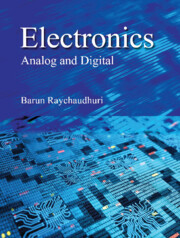Book contents
Summary
This is a separate category of transistor where the output current is controlled by the input voltage. There are two broad categories of such transistors, namely junction field-effect transistor (JFET) and metal–semiconductor field-effect transistor (MOSFET). The device construction, electrical characteristics and the related parameters of JFET and MOSFET are illustrated in this chapter. Different types of amplifier configurations realized with these devices are introduced.
‘Field-Effect’ and ‘Transistor’
Chapters 5 to 8 have gone through various properties of the three-terminal bipolar junction transistor (BJT) where the output current is controlled by another current at the input. The present electronic device is also three-terminal and it can amplify voltage and switch electrical signals. So this is also a transistor. However, unlike the bipolar transistor, the current through the output terminals is controlled by an electric field resulting from the voltage at the third terminal. Indeed the electric field may control the current conducting path of the output circuit without any direct electrical contact between the causing and the resultant parameters. That is why it is named field-effect transistor, abbreviated as FET.
The FET is contemplated in different forms. There is a category of junction FET (JFET) where the input voltage varies the depletion width of a reverse-biased p–n junction. Another group of FET having a metal electrode separated from the semiconductor by an insulator is known as metal-oxide-semiconductor FET (MOSFET). A remarkable difference from BJT is that unlike the participation of both electrons and holes, the output current in a FET is composed of either electrons or holes and accordingly the FET is referred to as unipolar device and majority carrier device. Both the JFET and the MOSFET have the following three terminals.
Source: It is the point through which the majority carriers enter the current carrying semiconductor bar, called channel. The source terminal of the FET may be compared to the emitter of the BJT.
Drain: Through this the terminal, the majority carriers flow out of the channel. The drain is analogous to the collector of a BJT.
Gate: It is the terminal with either a metal (for MOSFET) or a heavily doped region of opposite type semiconductor (p+ for n-channel and vice versa) (for JFET) meant for controlling the drain current. The gate is comparable to the base of the BJT.
- Type
- Chapter
- Information
- Electronics , pp. 276 - 312Publisher: Cambridge University PressPrint publication year: 2023



